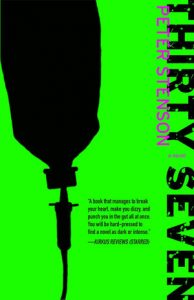Book Review
 Peter Stenson’s daring and unsettling novel Thirty-Seven explores the tension between health and sickness, and salvation and doom. The author employs all his skills to deliver a masterful novel of great significance. His prose is bold and disquieting, and his narrative gifts readily apparent as he weaves a disturbing and unusual story.
Peter Stenson’s daring and unsettling novel Thirty-Seven explores the tension between health and sickness, and salvation and doom. The author employs all his skills to deliver a masterful novel of great significance. His prose is bold and disquieting, and his narrative gifts readily apparent as he weaves a disturbing and unusual story.
The “Thirty-Seven” of the title refers to the young Mason Hues who at age fifteen becomes the thirty-seventh member of a religious cult in Colorado. The cult, led by a man who calls himself One, administers chemotherapy treatments to otherwise healthy people. When Thirty-Seven arrives at One’s compound, he sees the other members and notices that everyone “. . . was thin. So thin. The kind of thin anorexia made a feeble mockery of.” One’s goal is to make his charges sick in order to cure them—not of any physical disease, for they were otherwise healthy on arrival, but of the “selfishness forced upon us by a society that cares nothing for a single one of us.”
Throughout the novel, Thirty-Seven reveals the cult’s philosophy that he adopts as his own. He often states that “sickness bears honesty,” and the cult’s mission is “rebuilding ourselves among a loving family of our own choosing.” All the members of the group come from backgrounds of trauma and tragedy. Many have lost members of their own families to disease or accidents; others are scarred by events from childhood. Thirty-Seven is haunted by early memories of his father standing in the doorway of his bedroom masturbating while he slept.
To the cult, self-induced sickness generates a more harmonious, fulfilled life. While most of us would do anything to avoid pain and suffering, for One, Thirty-Seven and the others, sickness is the key to unlocking real human purpose. Sickness changes the fundamentals of human nature. One says:
Scientifically, we are different people after chemotherapy. Emotionally different. Spiritually different. There is no way to be brought to the brink of death through the destruction of ourselves, only to be nursed back to health through a loving family of our own choosing, and not be a different person. A person, who, above all else, leads with Honesty.
Sickness to the point of death molds an entirely new person with motivations far different than those of the bulk of humanity. Thirty-Seven truly does find a family of his own choosing. He is well cared for as he is given near fatal doses of chemotherapy. He loses weight, enduring great pain that leaves an “ache in my teeth . . . It felt as if the insides of each tooth—the deep center of my molars, the thin inner of my canines—had been infused with sugar and hydrochloric acid. Every breath caused a spark of pain.”
For all this, Thirty-Seven receives moments of absolute clarity within his sickness. After his second month he is “able to have a series of days when I wasn’t vomiting . . . And strangely, I liked how I looked. I liked the fact that I was nothing but bones and I liked the fact that my head was always cold and I liked the fact that everything was too big.”
For Thirty-Seven, intentional sickness brings spiritual enlightenment, but he soon discovers that the cult’s practices are growing increasingly extreme. One is keeping people in the compound against their will. Soon the entire community takes a hand in the execution of those who wish to leave, and in one grizzly scene, each removes a tooth from the victim to keep as a sacred item.
The novel is narrated by Mason after he has left behind the cult and his identity as Thirty-Seven. He falls in love with a woman named Tally, and gradually explains to her about his former life. She also gains understanding from an academic book called Doctor Sick that chronicles the rise and fall of the community. As the novel progresses, Stenson takes us on two paths: in flashbacks, Mason as Thirty-Seven lives with his cult-family, and in the present, Mason, at Tally’s insistence, forms a new family with himself as the new One, and Tally as Two. Mason and Tally shave their heads, wear surgical scrubs, and take medication to make them sick. They lose weight and live in a small room, creating a family of their own choosing. Both Mason and Tally get lost in the pursuit of sickness, and their self-protective boundaries fall away. At times they believe they see reality from the vantage point of God. Mason explains to Tally that his “body is a supernova swallowing itself, everything exploding through contradiction . . . something has to play the role of God, that something is us . . .”
Peter Stenson’s novel relentlessly questions our everyday human concerns. Mason Hues/Thirty-Seven’s story is a spiritual quest with fraught and dangerous moments. In fact, the line between spiritual quest and narcissistic venture are never clear in Thirty-Seven. By the end of the novel, Stenson reminds us that despite our religious visions or flights of fancy, eventually we must come home, and that homecoming can have grave consequences. We as readers are able to take Thirty-Seven’s trip without the danger, as Stenson’s skill and power as a writer serve as our trustworthy guide.
About the Reviewer
Eric Maroney has published two books of nonfiction and numerous short stories. He has an MA in philosophy from Boston University. He lives in Trumansburg, New York, with his wife and two children. His book of nonfiction prose, fiction, and poetry, The Torah Sutras, will be published by Albion-Andalus Books in 2018.